The Great Depression represented a new moment for government involvement in many facets of American life including a national photography project. The government-sponsored photography project documenting the experiences of Americans during these years of economic crisis existed from 1935 through 1942. The project was housed in various government departments’ including the Resettlement Administration, the Farm Security Administration, and the Office of War Information (FSA-OWI) spanning the years of 1935 through 1942. This project generated a collection of 270,000 still photographs and negatives that are housed at the Library of Congress. About a dozen photographers worked under Roy Stryker‘s leadership to create these pictures which have come to represent the quintessential picture of life during the Great Depression. This wealth of data has led many historians to examine the photographs from various perspectives. Many historians, including Maren Stange, have argued that the photographs were part of a social publicity project that “sought to portray social and economic management as a matter of smooth, humane, bureaucratic administration.”1 In addition, historians have postulated that inquiry of photographs cannot be divorced from the textual context in which they were used at a particular historical moment. These images became important pieces of political propaganda by the New Deal administration to delineate the scope of the crisis, justify the need for large-scale public spending, and document the successes of the government program. Cara Finnegan best sums up the administration perspective with her argument that the “New Deal government sought to visualize the management of poverty.”2
There are multiple ways to approach analyzing the FSA photographs. While most historians have focused on the dynamics between Stryker and the individual photographers examining the group project versus individual agency, other historians have focused on the manner in which particular groups were represented, such as African-Americans and women.3 Both women and African-Americans made up large numbers of one of the most important social protest movements of the Great Depression — the unemployed workers movement. During the Depression, so many people were not able to find work that the unemployed transitioned in the public eye from being a disaffected, alienated people to a part of the community that deserved public support. This is indicated by the widespread support for increased funding for relief and government work programs. This transition in public perception led to the emergence of very different images of the unemployed: while the government continued to focus on images of individuals downtrodden and disaffected by society, some images of the unemployed actively organizing for higher pay, more respectful treatment, and equal status in society began to surface.
This study seeks to build on the prior research work by examining conflicting images within the FSA collection of the unemployed. While the vast majority of FSA images of the unemployed portray them as passive, listless, and in need of assistance, there is a small body of FSA pictures showing the unemployed engaged in organizing through the national organization of the unemployed, the Workers Alliance of America. While there are only eleven images of the Workers Alliance, these few images provide a glimpse of a national, powerful movement that impacted the lives of the unemployed. For too long, the experience of the unemployed during the Great Depression has been viewed solely from the perspective of the New Deal reformers and the solutions they offered. This trajectory strips the unemployed of the power they had to develop their own alternatives and to fight for them. These two sets will be contrasted to the larger body of images that the FSA utilized to help promote the New Deal agenda.
There is another small series of pictures of the Workers Alliance of America in a collection of government photographs. These were images taken by Lewis Hine in the winter of 1936-1937 as part of the National Research Program of the WPA. In December 1935, a subsection of the National Research Program called the National Research Project on Reemployment Opportunities and Recent Changes in Industrial Techniques was organized to examine recent industrial innovations and consider their impact on employment. This came out of a widespread social belief that technological innovation had contribution to the development of mass unemployment. Hine was hired as chief photographer of the project in late 1936 and traveled to fourteen communities between December 1936 and July 1937. The pictures that Hine took of a Workers Alliance meeting in Scott’s Run, West Virginia were part of general views of the community, working conditions in factories, machinery, and workers that make up each of his photo studies. This study of images of the unemployed will analyze the contradictions between the stereotypical image of the downtrodden man and the broader diversity of experiences and responses by the unemployed to the economic crisis of the Great Depression.
There are various methodological issues to consider in conducting visual history. One of them is how to choose a set of images to analyze. In this case, I chose to focus on government-created images of the unemployed during the Great Depression. My first consideration was to look within the FSA-OWI collection. There are no set categorizations within the collection of unemployed images other than the term “unemployed” being included in the title of the photograph. Within those set of images, I selected images from different photographers and different geographic areas that spanned the period of time the unemployed were actively organizing — from the start of the photography program in 1935 through 1940.
Another methodological issue to consider is whether the photographs being analyzed were viewed by the public at the time. Many visual historians have argued the primary impact of images is how they influenced the public during the time they were created. But that is not always possible to evaluate In the case of the FSA-OWI photographs, the public viewed few of them during the Depression. When photographs from the FSA-OWI collection were shown, the emphasis was either on “project photographs” that documented the agency’s efforts to combat poverty or to display “American” subjects. Since the images of the unemployed, either as downtrodden or as militant, did not help fulfill these goals, this study could not rely on published images of the unemployed.
Stryker followed Lewis Hine’s documentary style: the main goal of the project was social reform, the second was historical preservation, and the third was to create “photo-stories” with detailed captioned of multiple images. By the time of the Great Depression, social documentary photography had become structured to appeal to a broad sensibility of the American public. Building on the Progressive era tradition of Hine and Jacob Riis, social documentarians sought to use photography to develop impetus for social reform. Dorothea Lange was particularly skilled at using photography to elicit concern and sympathy, but her photographs also conveyed also emotional distance. She hardly ever took images of people interacting with each other and instead sought to focus on the importance of individual diversity. Historian John Rogers Puckett describes Lange’s photographs as “a moment of withdrawal into self — of isolation and alienation with the world.”4
While most Americans realized the necessity for relief payments and even the government jobs programs, they were unwilling to give unconditional support for the unemployed. Right-wing opposition to the New Deal relief programs very successfully built opposition by focusing on government corruption scandals. There was a thin line in the American consciousness between people who needed a government hand-out to survive because no jobs were available and people who refused to work and had become permanently dependent on the state. New Deal administrators were adamant about building support only for the “deserving poor.” While this phrase had traditionally been limited to widows and children, it was now broadened to include any unemployed except “potential rebels and rioters, drifters and derelicts.”5 No one could predict how long the Great Depression would last, and many social scientists were arguing that mass unemployment had become a permanent condition of capitalism. Within this context, the New Deal administration developed a visual strategy to maintain the prevailing ideology about poverty and its individualist origins and yet to build support for relief measures against conservative opponents at the same time. Harry Hopkins, head of the Federal Emergency Relief Administration (FERA) and later the Works Projects Administration (WPA) argued that the unemployed were “fine people, the workers, a cross-section of America’s payrolls.”6 Thus Stryker set out to first document the prevalence of poverty amongst widespread sections of the population as a justification for the relief programs, and then document how government programs had led to success stories.
The iconographic image of the unemployed leading into the Great Depression was a crowd of single men loitering around in overcoats with blank expressions on their faces. These images of the unemployment represent the social displacement of the jobless and their alienation from society. These homeless men represented not only a threat to public safety and health; it was also commonly thought that long-term unemployment and homelessness led to “a hopelessness and despair which slowly destroys mental stamina and moral fiber until many of them will never be capable of resuming their former role in society.”7 This same opinion has been echoed by a generation of historians in 1950 summing up the general public attitude during the Great Depression: “People were sullen rather than bitter, despairing rather than violent.”
There are a series of urban images of unemployed that capture them in listless poses in places designated as “areas where bums hang out” or “the street of the unemployed.” If they are speaking to each other, it is on a one-to-one basis, but most of the time the men are staring at the ground or off into space. These men appear to be deeply socially isolated; the images do not show them having any contact with women or the rest of society. There are so many pictures framed like this at different points in time by different photographers that it appears this “downtrodden man” is a signature photograph of the Great Depression. These images are from the early “problem pictures” section of the FSA collection that served to identify major problems in American life.
Dorothea Lange, long considered the most important FSA-OWI photographer both because of her professional status and her famous “Migrant Mother” picture, took pictures of the unemployed in San Francisco in February 1937. The images that focus on the unemployed were taken on Howard Street which is identified as “Skid Row” and the identifiable buildings are religious missions. The men represent the “downtrodden man” disconnected from the rest of society and staring off into space.
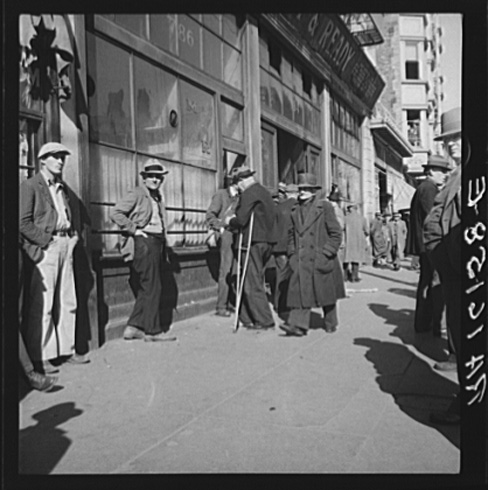
Dorothea Lange, “‘Skid Row’ Howard Street, the Street of the Unemployed in San Francisco, February 1937.” Call Number LC-USF34-016158-E. Farm Security Administration — Office of War Information Photograph Collection, Library of Congress Prints and Photographs Division.
In this image, the unemployed appear to be an indistinguishable line of bodies as far as the eye can see down the street. The men stand with their hands in their pockets and grim expressions on their faces. The image transmits the tone of despair with the man on a crutch in the background and the man slowly walking towards the camera in the foreground with his hands in his pockets. The looks that the unemployed give the photographer are neither curious, hostile, nor even interested; they do not shift their positions or turn towards the camera.

Dorothea Lange, “‘Skid Row,’ Howard Street, San Francisco, California, February 1937.” Call Number LC-USF34-016153-E. Farm Security Administration — Office of War Information Photograph Collection, Library of Congress Prints and Photographs Division.
In a second picture taken by Lange on the same trip to the “Skid Row,” she captures a single unemployed man standing next to a restaurant that has gone bankrupt. The farmer in his overall leans up against the wall of the building with the “To Lease” signs behind him. He is alone, hunched over with his hands in his pockets and his head down. His eyes are turned away from the photographer and he appears wary and defeated. These images capture the essence of the New Deal’s expose of the downtrodden man.
Russell Lee was another photographer hired by Stryker for the FSA project. He was a talented young photographer who had developed technical innovations with film due to his training as an engineer. He joined the FSA in the fall of 1936 and by the summer of 1937 was taking pictures of the unemployed in Minneapolis. He focused on the “Gateway District,” which is where single, unemployed men would assemble searching for work.
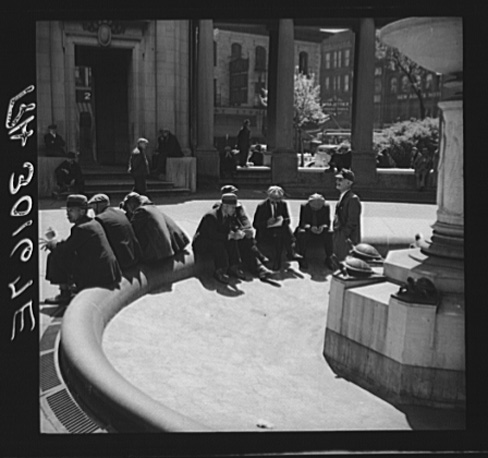
Russell Lee, “Unemployed Men Sitting in Public Square in the Minneapolis ‘Gateway’ District. June 1937.” Call Number LC-US34-030167-E. FSA-OWA Photograph Collection, Library of Congress Prints and Photographs Division
In the first image taken in June, a group of unemployed are sitting on the edge of a dry, public fountain. They sit quietly, some of them writing, most with their heads down. They appear just as sedentary as the turtles that are perched next to them on the fountain. The imagery in the photograph is of patient waiting. In the background, many more unemployed are assembled, sitting or standing still. An ominous sense of time slowly passing permeates the photograph, sending a message that these are men trapped outside of the society.
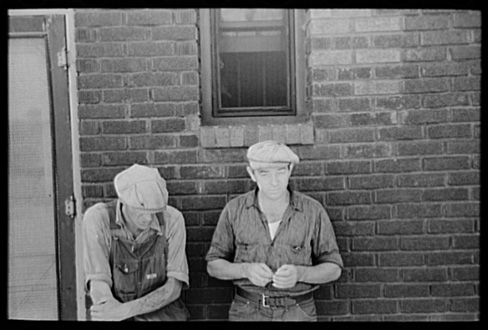
Russell Lee, “Two Unemployed Men, Gateway District, Minneapolis, Minnesota. August 1937.” Call Number LC-US33F-011286-ME. FSA-OWA Photograph Collection, Library of Congress Prints and Photographs Division
The second picture focuses on two individual unemployed men standing up against the wall. The man on the left is bent over with his hand on his knee and head down. He appears to be speaking to the man on the right; though a conversation may be taking place, the man on the right gives no indication of listening or participating in the discussion — instead he looks down and away. He plays with something in his hands — something to help the time pass. A single window in the wall is barred. The photograph, too, transmits a sense of timelessness and patient waiting. This theme runs through the majority of the FSA photographs of the unemployed.
Another FSA photographer who captured images of the unemployed was John Vachon, a young assistant who was hired to do office work for the Farm Security Administration. He was encouraged by Roy Stryker to take up the camera and received assistance from Walker Evans and Arthur Rothstein, two other FSA photographers. Vachon’s first solo photography trip, only two years after he began taking pictures, was to Nebraska in the winter of 1938. Vachon’s memory of instructions from Stryker were to use a recent article in Harper’s by George Leighton that detailed the business community’s failures, showed how this led to labor unrest and lynching attacks, but concluded that New Deal programs could solve the society’s problems. With this model in hand, Vachon set out to record both the poverty of the Depression and the possibilities of reform. He took a series of photographs of lower Douglas Street in Omaha, which he identified as one of the “hobo centers of the Midwest.”8
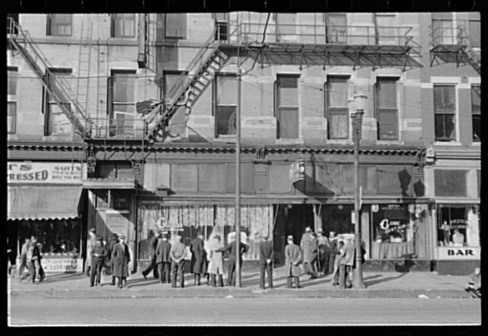
John Vachon, “Lower Douglas Street, Where Unemployed Hang Out, Omaha, Nebraska. November 1938.” Call Number LC-USF33-T01-001311-M5. Farm Security Administration — Office of War Information Photograph Collection, Library of Congress Prints and Photographs Division.
Vachon captured an image of a group of unemployed men on the street in Omaha. The image is similar to the Lange and Lee pictures of the unemployed: groups of unemployed men, clad in somber coats, lining up in the street, hanging around, with no place to go. A sense of suspended time permeates the image.
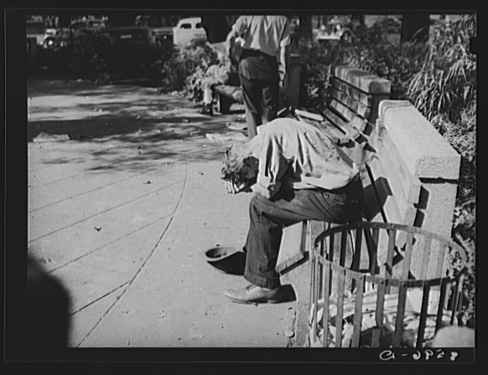
John Vachon, “Unemployed Youth, Washington, D.C., August 1938.” Call Number LC-USF34-008596-D. Farm Security Administration — Office of War Information Photograph Collection, Library of Congress Prints and Photographs Division.
The individual picture of “Unemployed Youth,” shot in Washington, D.C., depicts the despair of a generation of young men. There are other homeless men about in the park at the next few benches, but Vachon focused on the young man. His clothes are not in terrible shape, his jeans seem relatively new, and his shoes are not yet battered. Yet he is hunched over with his head in his hand. His hat lies next to him on the ground, as though seeking a handout. The message of the picture is clearly that the problem of unemployment is so great that a young, strong man like him cannot find work.
The similarity of the FSA pictures of the unemployed is not an accident. Stryker urged his photographers to quickly find places where the unemployed assembled, which explains the emphasis on the gathering points of single men. Certainly it is indisputable that large numbers of single men were displaced by the Great Depression and moved around the country seeking work. These images are not false representations of the “forgotten man.” But does this represent the whole scope of unemployed people’s experiences, or is it a single, limited view that obscures a larger narrative? William Scott, a photography historian, has argued that documentary photography was a distinct genre that implied truth and honesty but in reality this type of objectivity is very complex.9 In order to address the reality of unemployed experiences during the Great Depression, it is necessary to dig deeper into the historical record for additional views of the unemployed.
The flip slide to the image of the down-and-out, socially isolated unemployed is the representation of the unemployed as part of a workers movement, actively engaged in challenging the social model and demanding increased governmental support. This is the image that caused many people to reject the New Deal reforms, thus it was an image that the FSA project sought to avoid. The Great Depression was a period of tremendous upheaval in the social attitudes towards unemployment. With so many people out of work, the impact of unemployment was felt within every community. This led to much greater social sympathy for the unemployed, particularly in communities that had over 50% unemployment, like mining communities and African-American urban enclaves.
There were thousands of unemployed organizations built on local bases across the country that provided communal support for dealing with the relief office, demanding more benefits, trying to stop evictions and farm closures, and protesting cuts in aid. By joining these groups, individuals developed a community of support and began to view the unemployment problem in a more systemic manner. The length of the Depression allowed unemployed groups to reach out into statewide and national networks forming a web of organizations including the Unemployed Councils, the Unemployed Leagues, the American Workers Union, the California Workers Federation, and the Illinois Workers Alliance. These groups all came together at a national convention in Washington, D.C .to form a single unemployed organization called the Workers Alliance of America. This new powerful force claimed a membership of 800,000 members at its founding, making it the third largest labor organization in the United States after the American Federation of Labor (AFL) and the Congress of Industrial Organizations (CIO). The Workers Alliance held meetings, protests, strikes, marches, and occupations of state legislatures throughout the country defending the rights of the unemployed workers both in the relief offices and on the WPA job sites. They were successful in getting the Hopkins Administration to recognize WPA workers’ right to unionize and won significant gains, such as increases in wages and better working conditions. At each point when the New Deal Administration sought to cut back the WPA program, the Workers Alliance built public support to maintain the projects and lobbied government officials directly.10
The unemployed workers movement received an enormous amount of local and national press coverage. The New York Times reported on the unemployed workplace occupations on Works Project Administration (WPA) sites across the country.11 When the Workers Alliance called national strikes demanding increases and racial parity in pay on the WPA jobs, the national press responded with editorials both admiring the unemployed workers’ courage and condemning their greed. Even Life Magazine ran a series of articles about the Workers Alliance. But it garnered very little attention from New Deal-affiliated photographers.
This very different view of the unemployed engaged in protest movements demanding increased funding from the New Deal administration is missing entirely from the published FSA photographs and found in only very small numbers within the entire FSA collection. The omission is hardly surprising, given how different the unemployed workers movements’ goals were from the goals of the FSA. Yet it also speaks to the tensions between individual FSA photographers and Roy Stryker’s agenda that any pictures of the Workers Alliance were taken at all. Many of the photographers came to the FSA with a commitment to radical activism and were continually frustrated by the confines of the New Deal administration. Marion Post Wolcott refused to adjust her style to the pictures of individuals devastated by agrarian destruction. William Stott pointed out that Stryker’s limited agenda would “tell us little of real life experiences . . . (since the) images (were) meant to break our heart. They become helpless, guiltless as children.”12 Wolcott instead took complex pictures of community’s rejoicing together, and her images of poor women exuded sensual energy. Arthur Rothstein and Dorothea Lange also took many pictures of striking workers, even though this was specifically outside the boundaries of Stryker’s instructions. Thus the FSA-OWI collection must be viewed as an amalgamation of political agendas.
The entirety of the Workers Alliance pictures within the FSA are the few pictures of a Workers Alliance gathering Russell Lee photographed in Muskogee, Oklahoma in 1939; Dorothea Lange documented the Workers Alliance organizing in San Francisco in 1939; and Arthur Rothstein took a picture of an unemployed protest in Columbus, Kansas, in 1936. There is little accompanying historical documentation to give voice to the unemployed workers in the photographs. The closest equivalent is a single introductory speech at a Local #30 Workers Alliance meeting held in New York City on May 24, 1939 on West 130th Street, documented by the Federal Writers Project. The transcript is included in full in order to provide some context for the images even though it cannot be directly tied to the images.
Let’s git set, brothers n’ sisters; we’s got plenny a business t’have done. Time’s gittin’ late. If om chairman om eallin’ the meetin’ t’order. Take you seats now please. At’s it. Brother Finance, you got yo’ records awready, I hope? An you too, Brother Membership? — Let’s git settled — ‘at’s it. — O.K. brothers an’ sisters. I calls this meetin’ in full session. — First I suggests we stan’ up. Stan’ up, please. Let’s give a prayer on nis importan’ occasion, for on nis occasion we needs a bit a prayer t’help us along. —
O’Lawd, we is here gathered to say a prayer unto Yo’ fo’ help an inspiration. We ast Yo’ to listen t’ us an’ help us what we gonna do. We needs Yo’ help, Lawd, an’ ‘at’s why we startin’ nis meetin’ with Yo’ name, an’ offerin’ to Yo’ our hearts an our hopes. We is gathered here, all aus, black an’ white folks, in nis here organization because we is gonna do sump’n to git ourselves an’ our chil’ren food an’ cloes an’ decent lodgin’. We’s all a us poor folks, Laud; we ain’ neva had much an’ now this here relief don’ give us much. We all wants T’live like human men an’women, an’ wants our chil’ren t’be fed an clothed. — We been askin’ an’ askin’ at the relief station’ — t’git some of us onta relief that ain’ as yit, but it’s hard t’git on. Some a us ‘at’s on is bein’ out off an’ ‘at works hardships on us an’ on our chil’ren. — We’s goin’ t’decide at this meetin’ whut’s gonna be done an’ whuteva we decides we know we’s in the right fo’ we fightin’ hard fo’ our rights. — Some a us is black an’ some a us is white. An’ why are we here t’gether? Because we’s all folks in a same boat. We’s got wives an’ kids an’ we unastan’ ‘at hunger ain’ yit showed no favorites between the white an’ black skins. We knows Yo’ hol’ Yo’ chil’ren in a same regard, O’Lawd, no matter whut culla they be. We ain’ used t’be gathered here like this before, fer we wuz separated before — the whites fum the blacks an’ we didn’t have no respeck fo’ each other. It’s diff’rent now. This here’s a united front because we’s all sufferin’ alike. I knows Yo’ makes no distinction, fo’ it ain’ right an’ it ain’ human. An’ we in nis organization knows that if we black people wuz t’go alone they won’t be much use, same as with the whites. They ain’ no discrimination in Yo’ eyes, Lawd, an’ they ain’ none in nis here organization. — We’s askin Yo’ fer Yo’ blessin’s, Lawd, an’ t’keep us t’ gether an’ t’help us win in nis fight agens discrimination an’ agens our misery. We thanks Yo’, Lawd, an we gives Yo’ our hearts an our hopes, Amen.
Awright, brothers an’ sisters, let’s git started.13
The Harlem branch of the Workers Alliance was dominated by African-American leadership and members. Throughout the Workers Alliance, there was significant African-American participation, due both to the disproportionate impact of unemployment on the community and also the policy of racial inclusion of the organization.14 But the language used in this passage does not necessarily reflect the accurate manner of speech of the participants. The Federal Writers Project overwhelmingly recorded black speakers in back-country dialect. To what extent this reflects the reality of the interaction between the government project writers and the African-Americans being recorded is unclear.

Russell Lee, “Workers’ Alliance Meeting. Muskogee, Oklahoma, July 1939.” Call Number LC-USF34-033833-D. FSA-OWA Photograph Collection, Library of Congress Prints and Photographs Division.
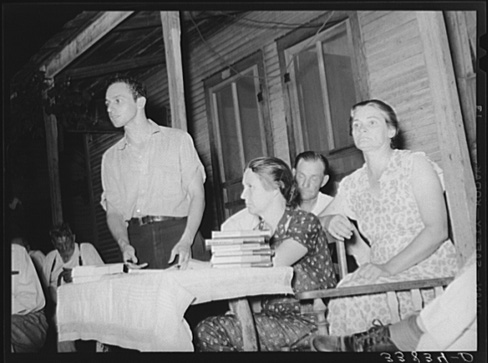
Russell Lee, “Workers’ Alliance Organizer Speaking at Meeting. Muskogee, Oklahoma. July 1939.” Call Number LC-USF34-033834-D. FSA-OWA Photograph Collection, Library of Congress, Prints and Photographs Division.
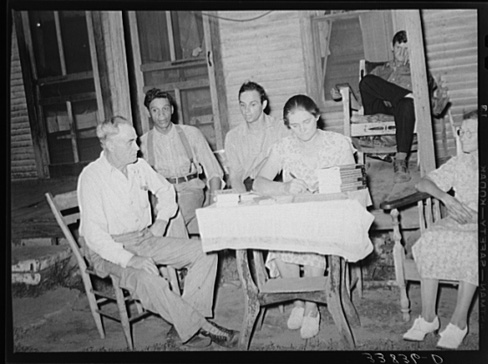
Russell Lee, “Officers of Local Workers’ Alliance, Muskogee, Oklahoma July 1939.” Call Number LCUSF34-033836-D. FSA-OWA Photograph Collection, Library of Congress, Prints and Photographs Division.

Russell Lee, “Stanley Clarke, Old-time Socialist of Oklahoma, Speaking at Workers’ Alliance, Muskogee, Oklahoma July 1939.” Call Number LC-USF34-033837-D. FSA-OWA Photograph Collection, Library of Congress, Prints and Photographs Division.
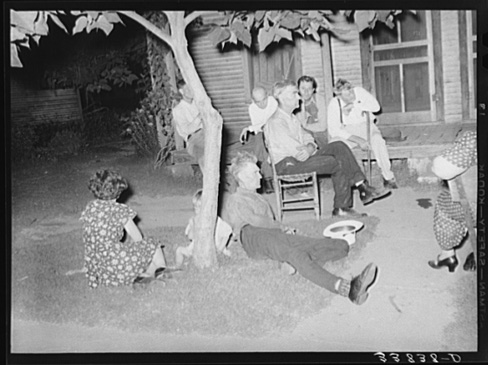
Russell Lee, “Part of Crowd at Workers’ Alliance Meeting. Muskogee, Oklahoma July 1939.” Call Number LC-USF34-033838-D. FSA-OWA Photograph Collection, Library of Congress, Prints and Photographs Division.
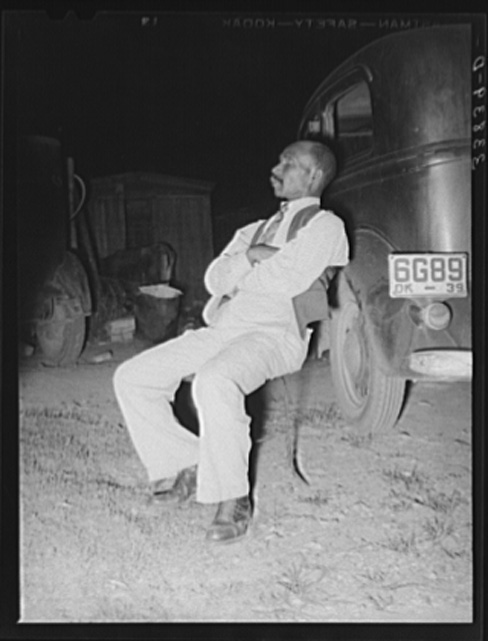
Russell Lee, “Negro Sitting in Chair Which Is Leaning against Car Listening to the Speaker at Workers’ Alliance Meeting, Muskogee, Oklahoma July 1939.” Call Number LC-USF34-033839-D. FSA-OWA Photograph Collection, Library of Congress, Prints and Photographs Division.
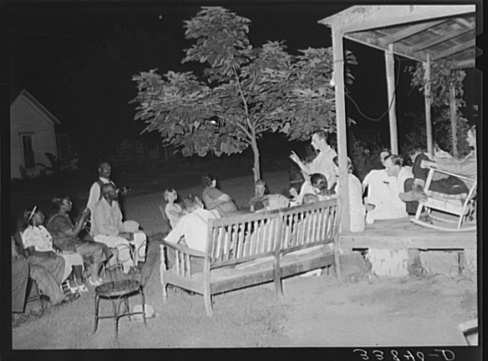
Russell Lee, “Negroes and Whites at Workers’ Alliance Meeting Listening to Organizer, Muskogee, Oklahoma July 1939.” Call Number LC-USF34-033840-D. FSA-OWA Photograph Collection, Library of Congress, Prints and Photographs Division.
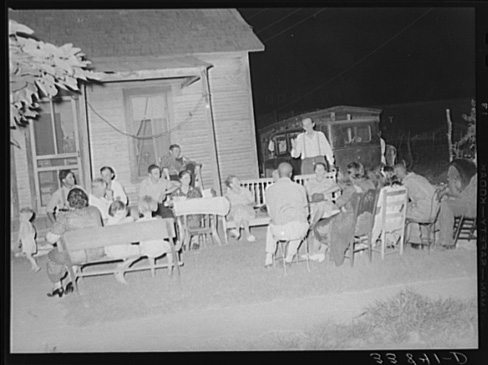
Russell Lee, “Negroes and Whites at Workers’ Alliance Meeting Listening to Stanley Clark, Old-time Socialist Leader in Oklahoma, Muskogee, Oklahoma July 1939.” Call Number LC-USF34-033841-D. FSA-OWA Photograph Collection, Library of Congress, Prints and Photographs Division.
The pictures that Russell Lee took in Muskogee, Oklahoma, in July 1939 show the mixed racial community that is indicated in the text from the New York City meeting. The Oklahoma meeting shows African-American and white men and women representing a wide range of ages, from young adults to elderly. At this meeting, fifteen to twenty people are sitting in a circle and lounging on the ground around the porch of a working-class home. In several of the photographs, Lee indicates that the speaker, an older white man, is Stanley Clarke, a well-known Socialist Party organizer in Oklahoma. Clarke’s presence indicates some type of involvement from Socialist Party activists within the group. This would not have been atypical for the unemployed organizations since left organizations played prominent roles within the unemployed workers movement by providing organizational and financial resources, as well as contributing an systemic analysis of the unemployment problem. However, it’s unclear if Clarke is a visiting speaker or a regular member of the group. He is not speaking at the leadership table, but appears to be making comments from the back of the meeting. There are not written documents from the Muskagee local to supplement the visual information in these images.
The setting of the meeting provides information about the group. First of all, the meeting is held at night, outside of a small house. Workers Alliance meetings were regularly held in the evenings throughout the country, reflecting the fact that many of its members were working during the day. The Workers Alliance took the principle of unity between employed and unemployed very seriously and sought to accommodate its working members. The furniture has been brought out of the house and placed in a semicircle round the leadership table. It’s difficult to say why the group is meeting outside — they do not seem uncomfortably hot from their gestures, and no one is dressed very lightly. The house is quite small, so it could be that there is not room in the cramped quarters to accommodate a meeting of fifteen to twenty people.
The seating is set up in a semicircle around the front leadership table, and people are sitting quite informally, sprawled on the ground and sitting on the porch swing. This casual atmosphere suggests a group that is accustomed to each other and has been meeting regularly for a period of time. The presence of children walking around the meeting and sitting on their parents’ laps shows the community-based nature of the group.
The meeting appears to be highly structured — there is a table with the local leadership who are identified by Lee as the officers of the local chapter. The officers include two middle-aged white women, an older white man, and two young African-American men. Even though Lee’s comments suggest there is African-American leadership in the local, the seating dynamics within the meeting indicate a certain amount of racial tensions. The African-American members are sitting together somewhat separate from the rest of the group and the African-American leadership is sitting behind the white leaders. While the meeting is clearly not segregated, it’s difficult to determine to what extent the African-American members are integrated as equal members.
The bi-racial aspect of the meeting is representative of the type of Communist Party organizing that was taking place throughout the 1930s. However, it is still surprising, considering that historians have identified racial relations in Oklahoma as very similar to those throughout the South. Racial tensions in Oklahoma exploded in a series of lynching in the first two decades of the twentieth century and the Tulsa race riot of 1921. African-Americans responded to these racist attacks by setting up separate towns, schools, and cultural institutions.15 Given the scope of the racial problems endemic through Oklahoma, the mixed racial character of the Workers Alliance meeting is quite interesting. Textual sources are needed to investigate the relationship between white and African-American unemployed workers in more depth.16
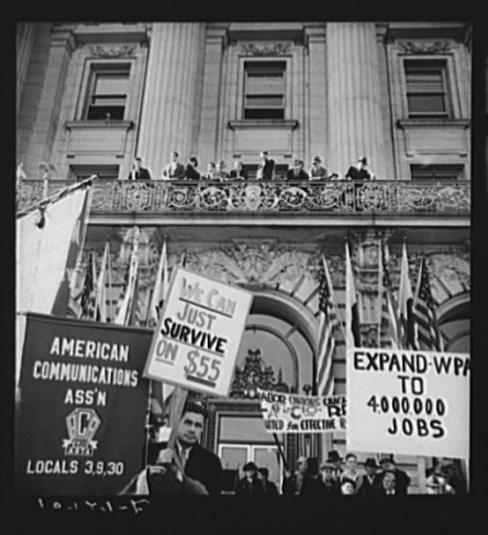
Dorothea Lange, “In Front of City Hall, San Francisco, California, The Worker’s [sic] Alliance, Works Progress Administration (WPA) Organize Simultaneous Demonstrations in the Large Cities of the Nation Cut in the Relief Appropriation by the United States Congress, February, 1939.” Call Number LC-USF340018927-E. OWI Photograph Collection, Library of Congress, Prints and Photographs Division.
In addition to community meetings, the Workers Alliance also held strikes and marches. In February 1937, the Workers Alliance held protests all across the country demanding an end to WPA cuts and higher wages. Dorothea Lange documented the protest march that took place in front of city hall in San Francisco, California. The picture shows two of the Workers Alliance signs — “We Can Just Survive on $55” and “Expand WPA to 4,000,000 Jobs” — along side traditional trade union signs representing the American Communications Association and the CIO. The picture focuses on the signs, the flags, and the crowd on the balcony, which could be reporters and/or police officers. The one man holding a Workers Alliance sign is very clean-cut and dressed in a suit and tie. This is an interesting view of the Workers Alliance in that historians have traditionally positioned the unemployed workers movement as separate from the trade union movement. This image suggests considerable collaboration between the traditional unions and the unemployed unions.
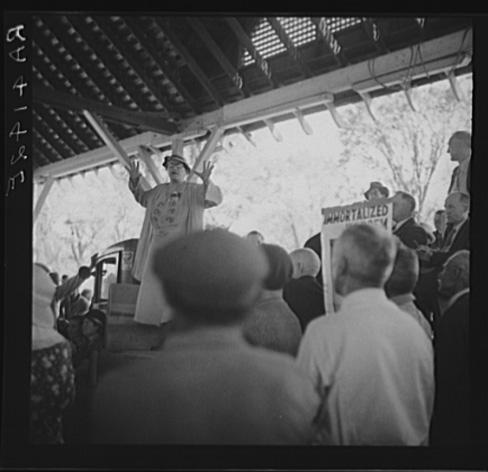
Arthur Rothstein, “Demonstration of Unemployed, Columbus Kansas, May, 1936.” Call Number LCUSF34-004142-E. OWI Photograph Collection, Library of Congress, Prints and Photographs Division.
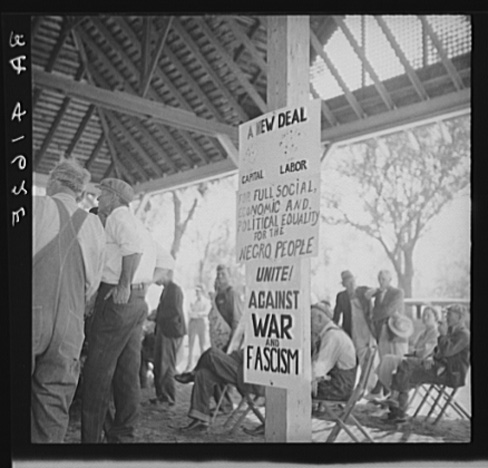
Arthur Rothstein, “Demonstration of the Unemployed, Columbus Kansas, May, 1936.” Call Number LC-USF34-004162-E. OWI Photograph Collection, Library of Congress, Prints and Photographs Division.
The last two images of the unemployed workers movement within the FSA-OWI collection are from a demonstration in Columbus, Kansas in May 1936. While these are not officially labeled as representing the Workers Alliance of America, the sign in one of the photographs reads, “A New Deal: For Full Social, Economic and Political Equality for the Negro People. Unite! Against War and Fascism.” This is the Communist Party line in early 1936 and strongly suggests that the Communists have organized the meeting. If this is the case, then this is a Workers Alliance meeting, since the Communists merged into the Workers Alliance of America at a national convention in April 1936. The first image shows a woman speaker standing on a platform above the crowd. A significant group of farmers, mostly white men but some women, are listening to her speech. The second image is taken from the back of the demonstration showing more farmers listening to the speakers. People are both standing and sitting down on chairs, suggesting a lengthy event. One young man turning towards the camera is standing with a banner across his chest. There has been no research work done on the unemployed workers movement in Kansas in the spring of 1936, though primary sources may exist.
The main photography project during the New Deal Administration that has received so much popular attention is clearly Roy Stryker’s collection. However, there was potential competition to Stryker’s project from Lewis Hine. By the mid 1930s, Hine was seeking work and approached Stryker to join the FSA project but was rebuffed several times. One possible reason Stryker refused to hire Hine was the basic issue of control. Stryker had ongoing problems with his photographers who sought greater personal control over their work. After various struggles with Lange and Mary Wolcott Post, he turned to hiring young, inexperienced photographers who would closely follow his direction. Hine clearly did not fit these criteria — in fact Lori Oden points out that he was not willing to relinquish rights to his negatives. Realizing that the FSA project was not possible, Hine sought another government job taking photographs and found a place within the WPA National Research Program.17
As part of this project, Hine documented a fleeting moment in the unemployed workers movement in Scott’s Run, West Virginia. This view of the Workers Alliance that Hine captured in late 1936 is very different than the FSA photographs of the organization. He went far beyond a few photographs of the unemployed workers meeting to document conditions for the unemployed miners. His emotionally sensitivity towards his subjects is unsurpassed. One must question why Stryker was so critical and claimed that Hine was beyond his peak. One possible conclusion is that Stryker was concerned about Hine’s reputation usurping the attention that the FSA photography project received. This is a speculative conclusion, since none of the historical information gives a clear answer as to why Stryker was dismissive of Hine’s work.
Lewis Hine’s work through the National Research Project provide an insight to life in Scott’s Run in late 1936 and early 1937. Hine was the only photographer that was able to capture the organizing work going on within the community, continuing his lifelong focus of portraying working people not as victims but as people with dignity. There are three different views of the unemployed: the first is the individual and small group vignettes of the unemployed, the second is a broader group of unemployed collecting their relief checks, and the third is Workers Alliance meetings where the community is meeting together. Hine’s work follows very much the style of his earlier projects: the pictures include extensive captions offering insight into the lives of the unemployed. In addition, Hine seeks several pictures of a particular moment in an attempt to capture a multi-dimensional view of people and their lives.

Scott’s Run, West Virgnia. Peter Percupu, Unemployed Romanian Miner, March 19, 1937. National Archives, Washington DC, Record Group 69: Records of the Works Projects Administration, 1922-1944. ARC Locator Number 518417.

Scott’s Run, West Virgnia. Peter Percupu, Unemployed Romanian Miner, March 19, 1937. National Archives, Washington DC, Record Group 69: Records of the Works Projects Administration, 1922-1944. ARC Locator Number 518422.
The first series of pictures focus on the Romanian community. Hine focused on two Romanian unemployed miners. There are two images of Peter Percupu, one of them with his head down and an expression of despair and the other with his head up smiling broadly into the camera. Hine’s caption informs us that Percupu is too old to continue working in the mines and his nickname is “Ground Hog.” The image of Percupu looking despondent show the pain etched in his face. The tense creases in his closed eyelids and his clenched jaw express the endurance of suffering. In the second image where he looks straight at the camera, his eyes in slits and eyebrow slightly raised, he appears frustrated and expectant. The third image broadens our understanding of Percupu by forcing us to consider that poverty is about more than suffering. In this image, Percupu stands chin up with his hand on his chest and a tight-lipped smile on his face. He exudes pride, sincerity, and strength. Even though he is now too old to work in the mines, his nickname indicates that he was held in high regard by his community for his years underground. From Hine’s visual and textual commentary on Percupu, we learn that he has not just self-respect but also a certain level of status.
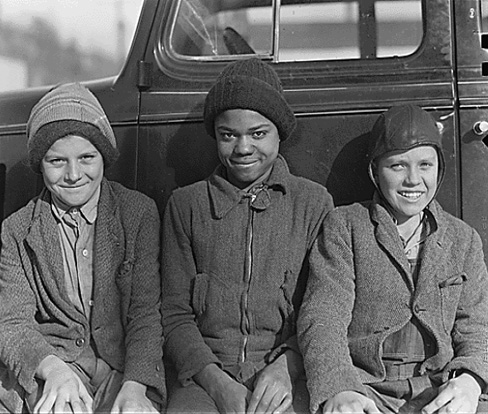 Scott’s Run, West Virginia. Children of Miners, March 19, 1937. National Archives, Washington DC, Record Group 69: Records of the Works Projects Administration, 1922-1944. ARC Locator Number 518410.
Scott’s Run, West Virginia. Children of Miners, March 19, 1937. National Archives, Washington DC, Record Group 69: Records of the Works Projects Administration, 1922-1944. ARC Locator Number 518410.
The second view of the mining community is a picture of three of the miners’ children. These are young boys, probably about ten years old, all sitting together on the fender of an automobile. The brief caption on this picture is “Children of Miners.” There are many pictures of children of the unemployed in the FSA collection; what makes this picture different and compelling is the way it shows deep-seeded integration in Scott’s Run. The openness in the faces of the boys and the genuine warmth in their expressions suggest a deep bond of friendship between them. Hines captures a bittersweet moment when the despair of poverty is subsumed in the pleasure of youth and camaraderie.
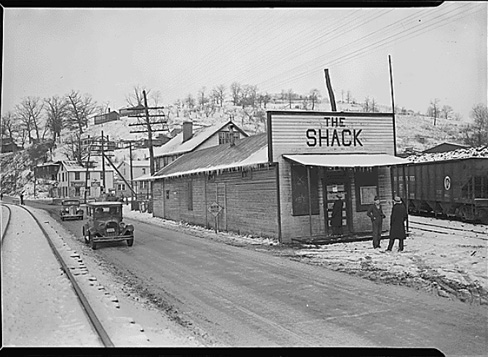
Scott’s Run, West Virginia. The Shack Community Center, 1936-1937. National Archives, Washington DC, Record Group 69: Records of the Works Projects Administration, 1922-1944. ARC Locator Number 518360
Hines opens up his glimpse into Scott’s Run by showing the social interaction at “The Shack.” This was a community center set up by the Morgantown First Presbyterian Church as a home missionary project to “Americanize” the diverse immigrant community in Scott’s Run and presumably to forestall radicalism amongst the miners. The head of the center, Mary Behner, set up a library and etiquette classes and bible school that focused on honesty, reverence, and teamwork. After the impact of the Depression began to set in, many other groups began to notice the poverty in Scott’s Run. American Friends Services Committee intervened with its Coal Relief Program in 1931 and began providing hot lunches and milk for children and nursing mothers. When the local banks shut down and the funds of various charity organizations were lost, the Salvation Army came to town handing out rock-hard and moldy bread that was five days old that people were glad to be given. The Red Cross refused to provide assistance, stating a policy that it did not offer help to victims of industrial unemployment. One of the miners points out his dilemma that the scrip being paid for a long day’s work in the mines were so low after deductions from the company town and company store that it was better to “starve in the sunshine.”18
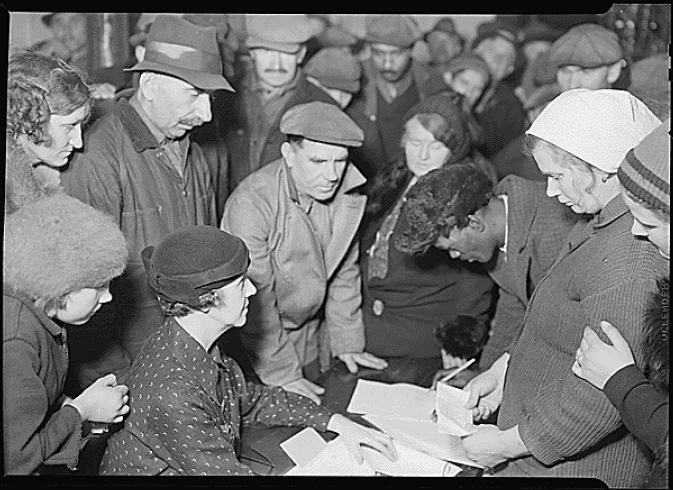
Scott’s Run. A Group of Men and Women. March 19, 1937. National Archives, Washington DC, Record Group 69: Records of the Works Projects Administration, 1922-1944. ARC Locator Number 518406.
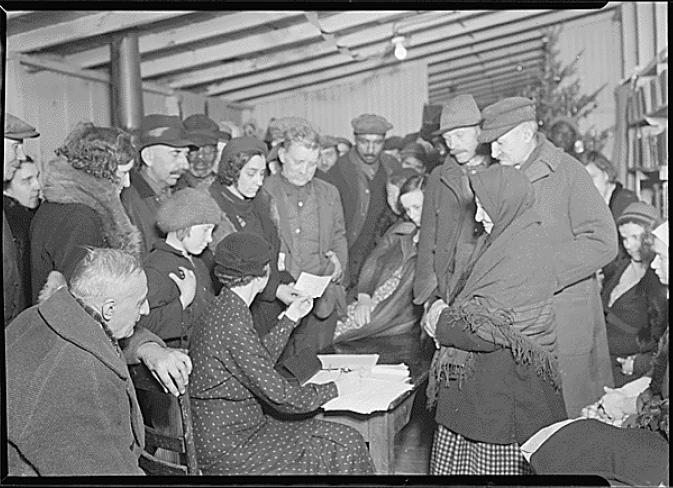 Scott’s Run. A Gathering of Men and Women. March 19, 1937. National Archives, Washington DC, Record Group 69: Records of the Works Projects Administration, 1922-1944. ARC Locator Number 518405
Scott’s Run. A Gathering of Men and Women. March 19, 1937. National Archives, Washington DC, Record Group 69: Records of the Works Projects Administration, 1922-1944. ARC Locator Number 518405
This desperation led to organizing responses from the local community and the center of groups organizing was in “The Shack.” Lewis Hine took pictures of community members gathered around a woman at the table inside The Shack in December 1936. There is a Christmas tree in the corner, but the occasion is not one of festivity. Everyone is huddled in their overcoats, leaning forward expectantly towards a small table — it appears that the woman is a local government agent handing out relief checks. The group appears nervous and agitated, as though there is tension in the air over the money distribution. The expression on the community members’ faces is drawn and wan, expectant and yet prematurely disappointed. Hine’s commentary on these photographs does not convey additional information about the event, but it is clear that the community members are expecting assistance from the woman seated at the table.
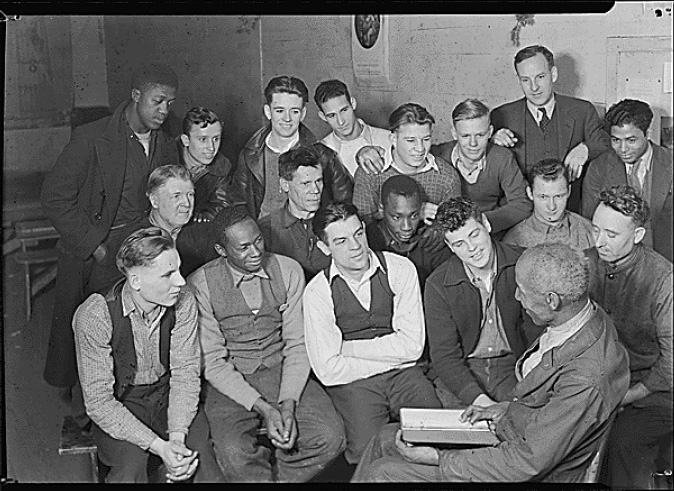 Scotts Run, West Virginia, Unemployed Men Attending Meeting of the Workers Alliance Council. 1936-1937. National Archives, Washington DC, Record Group 69: Records of the Works Projects Administration, 1922-1944. ARC Locator Number 518367
Scotts Run, West Virginia, Unemployed Men Attending Meeting of the Workers Alliance Council. 1936-1937. National Archives, Washington DC, Record Group 69: Records of the Works Projects Administration, 1922-1944. ARC Locator Number 518367
 Scotts Run, West Virginia, Unemployed Men Attending Meeting of the Workers Alliance Council. 1936-1937. National Archives, Washington DC, Record Group 69: Records of the Works Projects Administration, 1922-1944. ARC Locator Number 518362
Scotts Run, West Virginia, Unemployed Men Attending Meeting of the Workers Alliance Council. 1936-1937. National Archives, Washington DC, Record Group 69: Records of the Works Projects Administration, 1922-1944. ARC Locator Number 518362
The local branch of the unemployed workers movement also met in The Shack. Rather than waiting around to find out what the government would provide in terms of relief payments and government jobs, they were demanding larger cash payments. These are the only existing images of the Workers Alliance group from Scott’s Run, West Virginia. Historians have focused exclusively on the labor strife among miners, without considering the importance of the unemployed organizing.19
The earlier fleeting images from the FSA collection of Workers Alliance meetings suggest a complex arrangement of racial and gender dynamics were at work within the organization. But none of the images displays the type of racial dynamics that Hine captured in West Virginia. The Oklahoma pictures by Russell Lee suggest that, even though whites and African-Americans are meeting together, the tensions are bubbling at the surface; such tensions are not evident in Scott’s Run. In all three pictures by Hine, the elder African-American leader of the group is sitting off to the side in front and all the men at the meeting are staring at him intently with warm expressions on their faces. The extensive notes on the images tell us that there are two generations of immigrant unemployed miners at the meetings — the older men are immigrants, and the younger men are native born. All the African-Americans are of a younger generation. The leader of the group is the only older African-American present.
The federal government began to investigate the conditions in Scott’s Run in 1932 when Lorna Hinkok, a reporter hired by Roosevelt to investigate the types of conditions that average people were experiencing, was sent on a fact-finding mission. She recorded the poverty in the Scott’s Run and recommended that Eleanor Roosevelt intervene in bettering conditions.20 Taking up the recommendation, Eleanor Roosevelt made several trips to Scott’s Run, and in October 1934 Mary Behrer took her on a tour around the area to examine the dissolute bankrupt mining town of Jere, which was adjacent to Scott’s Run. Roosevelt responded to the problem in Scott’s Run by promoting the establishment of a government-sponsored homestead community called Arthurdale in nearby Reedsville, West Virginia. The government brought 165 displaced mining families into the community and provided land, homes with indoor plumbing and electricity, and schools that would replace The Shack as the community center of the area. However, instead of Arthurdale replicating the vibrant immigrant and African-American flavor of Scott’s Run, it became a white-only Protestant community.21
Lewis Hine was in a class all by himself as a New Deal photographer, both in terms of how much detail he provided about the people he photographed and the context he provided for how they fit into their communities. His Workers Alliance pictures provide a view of the Scott’s Run community that is not present in any of the news or government reports of the devastated mining area. It shows a community where the African-Americans, immigrants, and native-born have come together to seek solutions to the problems of unemployment and poverty. By connecting with a broader, national unemployed workers movement, they are reaching out beyond the isolation of the company-controlled mining towns. This is a truly bittersweet moment, because all the solutions offered to solve the mass unemployment disregarded the community ties and resistance that developed inside the Workers Alliance.
The government images of individual unemployed people and the unemployed workers movement present a complex picture of a transition period. While the New Deal Administration sought to tightly control the public perception of the unemployed, the community-based organizer belied that possibility. Even within its own photography project, the New Deal administration could not stop pictures of the unemployed actively engaged in making demands on the government from emerging. The few images that are available, both from the FSA-OWI collection and Hine’s National Research Project, illuminate a complex social movement that was seeking to redefine the status of poor people in society. Not only did the unemployed seek social legitimating, they also demanded the right to work and be treated as equal members of the labor movement. Due to the disproportionate number of women and African-Americans affected by unemployment, as well as the dominance of radical agendas within the movement, many women and African-Americans took on active roles and even leadership positions within the movement. These images show these shifting roles in various states of development. In Oklahoma, it appears that white women were in the leadership but that African-Americans may not have had equal status within the organization. The Workers Alliance chapter in Scott’s Run, West Virginia was led by an African-American man and the organizations was deeply integrated, but the meeting did not include any women. These are only a few glimpses into a powerful, national movement and represent only the beginning of a serious historical study of the images of unemployed activism during the New Deal period.
1 Maren Stange, Symbols of Ideal life: Social Documentary Photography in America, 1890-1950 (Cambridge University Press, 1989).
2 Cara A. Finnegan, Picturing Poverty: Print Culture and FSA Photographs (Washington: Smithsonian Books, 2003).
3 Nicholas Natanson, The Black Image in the New Deal : The Politics of Fsa Photography (Knoxville: University of Tennessee Press, 1992); and Judith Fryer Davidov, Women’s Camera Work: Self/Body/Other in American Visual Culture (Durham: Duke University Press, 1998).
4 Melissa A. McEuen, Seeing America: Women Photographers between the Wars (Lexington: University of Kentucky Press, 2000), citation on page 114.
5 Ibid, 104.
6 Finnegan, 20.
7 Joan M. Crouse, The Homeless Transient in the Great Depression: New York State, 1919-1941 (Albany: State University of New York Press, 1986); Francis E. Brown, “The Unemployment Crisis,” Current History (New York) 36:4 (July 1932): 413.
8 Carl Fleischhauer and Beverly Brannan, Documenting America, 1935-1943 (Berkeley: University of California Press, 1988). Fleischhauer and Brannan cite Vachon, who underscored “the straightened circumstances of two transients he photographed on lower Douglas Street”: “These men are both past 60. Neither of them ever expects to work again. They ride freight trains from Omaha to Kansas City to St. Louis and back again.” While Vachon did include this comment on a picture of two men in Omaha, it was not from lower Douglas Street, but an area down by the stockyards which was a different section of town. Unfortunately, Vachon did not include any substantive commentary on the pictures he took on lower Douglas Street. Citation to image LC-USF33- 001307-M2.
9 Lili Corbus Bezner, Photography and Politics in America: From the New Deal into the Cold War (Baltimore: The John Hopkins University Press, 1999).
10 Franklin Folsom, Impatient Armies of the Poor: The Story of Collective Action of the Unemployed, 1808-1942 (Niwot, University Press of Colorado: Niwot; 1991); Kirk W. Fuoss, Striking Performances/Performing Strikes (Jackson: University Press of Mississippi, 1997); Chad Alan Goldberg, “Contesting the Status of Relief Workers during the New Deal: The Workers Alliance and the Works Progress Administration, 1935-1941,” Social Science History 29.3 (Fall 2005): 337-371; James J. Lorence, Organizing the Unemployed: Community and Union Activists in the Industrial Heartland (Albany: State University of New York Press, 1996).
11 “Police Break WPA Strikers’ 10-Day Siege; 200 Peacefully Leave Wisconsin Capitol,” New York Times (March 22, 1936): 1; “Job Holders Grab Seats; Jobless Kept Out,” The St. Louis Post Dispatch (May 10, 1936): 3A in WPA Clipping File, National Archives (hereafter referred to as WPACF, NA); “St. Louis Jobless Hold Relief Office: Group of 100 Plans March to Meeting of Board of Aldermen,” Baltimore Morning Sun, (May 11, 1936): 1 in WPACF, NA; “‘Hunger Army’ Besieges St. Louis City Hall,” Baltimore Morning Sun (May 12, 1935): 6 in WPACF, NA; “To March on St. Louis City Hall,” New York Times (May 11, 1936): WPACF, NA; “Jobless in New Demonstration at Relief Station: Demand Immediate Allotments of Food, Hooting at Administrator’s Plea That They Leave,” The St. Louis Post Dispatch (May 11, 1936): 3A in WPACF, NA; “‘Hunger Armey’ Encamps Outside St. Louis Hall,” Baltimore Morning Sun (May 11, 1936): 6 in WPACF, NA; “St. Louis Hunger Army Camps at City Hall: 100 Determined to Stay Until Relief is Voted,” Philadelphia Inquirer (May 12, 1936): 1 in WPACF, NA; “Relief Office Camp: 35 St. Louis Unemployed Invade Building,” New York Sun (May 13, 1936): 21 in WPACF, NA; “St. Louis Jobless Renew Demands: Prepare to Make Second March on City Hall,” New York Times (May 12, 1936); 18 in WPACF, NA; “Workers Alliance Conducts Mock Session in Senate as Solons Leave,” Columbus Dispatch (July 7, 1936): 1B in WPACF, NA.
12 William Stott, Documentary Expression and Thirties America (Chicago: University of Chicago Press, 1986).
13 “Workers Alliance,” May 24, 1939. American Life Histories: Manuscripts from the Federal Writers’ Project, 1936-1940.
14 Mark Naison, Communists in Harlem during the Depression (Champaign, IL: University of Illinois Press; 1993).
15 Jimmie Lewis Franklin, Journey Toward Hope: A History of Blacks in Oklahoma (Norman: University of Oklahoma Press, 1982); Hannibal B. Johnson, Acres of Aspiration: The All-Black Towns in Oklahoma (Austin, TX: Eakin Press, 2002); Kenneth Marvin Hamilton, Black Towns and Profit: Promotion and Development in the Trans-Appalachian West, 1877-1915 (Urbana: University of Illinois Press, 1991); Scott Ellsworth, Death in the Promised Land: The Tulsa Race Riot of 1921 (Baton Rouge: Louisiana State University, 1982).
16 This is an area that needs more investigation. Cora Finnegan points to various WPA reports that show relief rolls very high in Oklahoma in 1937, with more than 20% of farmers on relief. There are also several doctoral dissertations examining the unemployed in Oklahoma during the 1930s and may be references to organizing in Oklahoma in the national newspaper of the Workers Alliance, Work.
17 Barbara Head Millstein, “Lewis Wickes Hine: the Final Years — Photographer,” Magazine Antiques, November 1988; Lori Oden, “Biography of Lewis Hine: Photography for Social Reform,” International Photography Hall of Fame.
18 Brenda J. Flinn, “A History of The Shack,” January 2003; Louis Stark, “Fare Worst in Mines of West Virginia: Poverty and Want Stalk Families of Lowest Paid Non-Union Coal Diggers,” New York Times, November 29, 1931: p. N39; Christine M. Kreiser, “‘I Wonder Whom God Will Hold Responsible’: Mary Behner and the Presbyterian Mission on Scott’s Run,” West Virginia History 53 (1994): 60-92.
19 Joe William Trotter, Jr., Coal, Class and Color: Blacks in Southern west Virginia, 1915-1932 (Urbana: University of Illinois Press, 1990); William M. Boal, “Estimates of Unionism in the West Virginia Coal, 1900-1935,” Labor History 35.3 (1994): 429-441.
20 Richard Lowitt and Maurine Beasley, eds. One Third of a Nation: Lorena Hickok Reports on the Great Depression (Urbana: University of Illinois Press, 1981); Jerry Bruce Thomas, “‘Please Tell the President . . . Only an Absolute Dictatorship Will Save Us’: Lorena Hickok Reports on the Great Depression in West Virginia, August 1933,” West Virginia History 57 (1998): 135-161.
21 Jerry Bruce Thomas, An Appalachian New Deal: West Virginia in the Great Depression (Lexington: University Press of Kentucky, 1998); Nancy Hoffman, Eleanor Roosevelt and the Arthurdale Experiment (North Haven, CT: Linnet Books, 2001); Thomas A. Coode and Dennis E. Fabbri, “The New Deal’s Arthurdale Project in West Virginia,” West Virginia History 36.4 (July 1975): 291-308.

Jeannette Gabriel is a doctoral student in unemployed workers history at the CUNY Grad Center. She works with New Jersey Civil Rights Defense Committee, which has been fighting against the illegal detention and torture of immigrants since 9/11. Jeannette is also a member of the Workers Democracy Network. She recently taught a class on immigrant workers’ history
